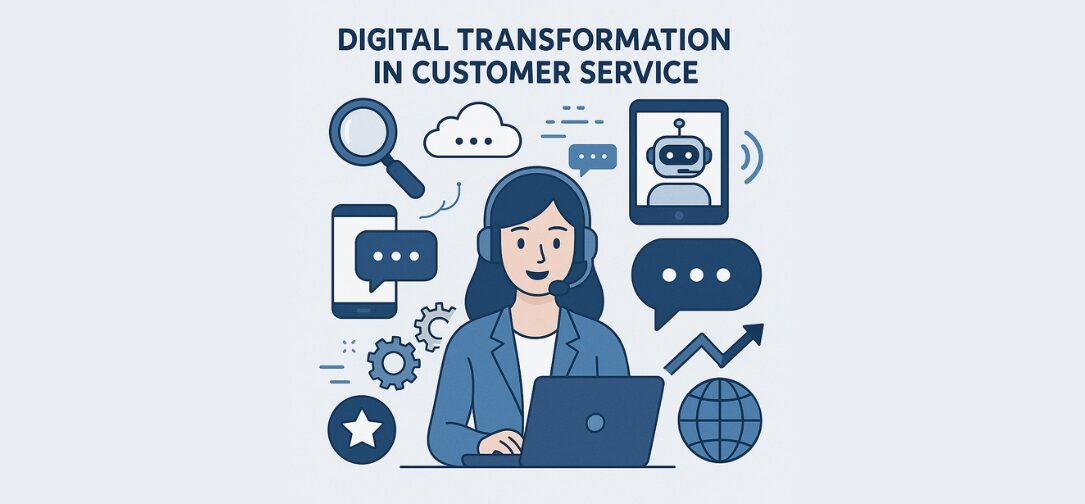Digital transformation in customer service represents a fundamental reimagining of how organisations interact with their customers through the strategic application of digital technologies. Today’s customers expect seamless, personalised, and immediate service across multiple channels—a far cry from the phone-only support desks of yesteryear. These heightened expectations have created both challenges and opportunities for businesses across every sector. The value proposition is clear: organisations that successfully transform their customer service operations enjoy higher satisfaction ratings, improved loyalty, and ultimately, stronger revenue growth. This article outlines a practical journey for transformation that begins with manageable first steps before scaling into a comprehensive digital customer experience ecosystem.
Assessing Your Starting Point
Before embarking on any digital transformation initiative, it’s crucial to thoroughly understand your current position. In Australia, many businesses are turning to specialised Perth Web Design & web development services to create custom solutions that address their unique customer service challenges. These local development partners offer advantages through their understanding of the Australian market and consumer behaviour, while providing the technical expertise needed to build scalable digital solutions. Whether you’re considering custom development or off-the-shelf options, start by evaluating your existing customer service infrastructure, including all technologies, processes, and team structures currently in place.
Five key steps to assess your starting point:
- Audit existing systems: Document all customer service technologies, communication channels, and automation tools currently in use.
- Identify pain points: Gather feedback from frontline staff and customers to pinpoint moments of friction in the service journey.
- Map the customer journey: Create visual representations of how customers interact with your service team across all touchpoints.
- Benchmark against competitors: Research industry standards for key metrics like response time, resolution rate, and customer satisfaction.
- Establish success metrics: Define clear, measurable goals that will indicate successful transformation—whether that’s reduced resolution times, improved CSAT scores, or decreased service costs.
Building the Foundation
A successful digital transformation begins with a robust foundation. Develop a customer-centric digital strategy that places customer needs and preferences at its core, rather than being driven solely by operational efficiencies.
Four foundational elements for successful transformation:
- Executive sponsorship: Secure genuine leadership buy-in with clear articulation of both business benefits and customer impact.
- Cross-departmental alignment: Create a shared vision across marketing, sales, IT, and operations to prevent siloed implementation.
- Dedicated transformation team: Establish a focused group with representatives from affected departments, technical specialists, and change management experts.
- Data infrastructure planning: Audit your current data architecture to identify integration challenges and build a unified customer data platform.
Budget planning should account not only for technology investments but also for training, change management, and potential productivity dips during implementation phases. Set realistic ROI expectations, recognising that some benefits will be immediate while others may take months or years to fully materialise.
Where to Start: Quick Wins and First Steps
Begin with achievable projects that demonstrate value quickly.
Six quick wins to jumpstart your transformation:
- Implement chatbots: Deploy AI assistants for handling routine enquiries to reduce wait times and free human agents for complex issues.
- Enhance self-service: Develop comprehensive knowledge bases and intuitive FAQs that empower customers to find answers independently.
- Streamline omnichannel communication: Implement systems that maintain conversation context across channels to eliminate repeated information.
- Automate ticket routing: Ensure enquiries reach the right specialist without multiple transfers through intelligent categorisation.
- Deploy basic analytics: Start gathering insights into common issues, peak service times, and resolution efficiency.
- Optimise mobile experience: Ensure all digital service touchpoints are fully responsive and mobile-friendly.
These initial steps can deliver noticeable improvements in customer experience while building organisational confidence in the transformation journey.
Technology Selection and Implementation
Selecting the right technology ecosystem requires careful consideration of both current needs and future scalability.
Five key considerations for technology selection:
- Capability alignment: Evaluate platforms based on their ability to support your unique service processes and integrate with existing systems.
- Deployment model: Weigh cloud versus on-premises options—cloud solutions generally offer greater scalability and lower upfront costs.
- AI readiness: Assess machine learning capabilities with a practical lens, starting with proven applications before moving to complex implementations.
- Integration requirements: Ensure new platforms can connect seamlessly with your existing technology ecosystem.
- Customisation balance: Find the sweet spot between highly tailored solutions and the reliability of established products.
The most successful implementations typically involve core platforms with targeted customisations in areas that provide competitive differentiation, rather than building everything from scratch. Professional Development Services can greatly accelerate this process, ensuring you implement solutions that align with industry best practices while meeting your specific needs.
Change Management and Training
Technology deployment represents only half the transformation equation; preparing your people for change is equally critical.
Seven essential change management strategies:
- Transparent communication: Clearly articulate how technology will enhance rather than replace human roles.
- Skills development: Create comprehensive training programs that build both technical proficiency and complementary soft skills.
- Champions network: Identify and empower influential team members who can advocate for new approaches.
- Phased implementation: Roll out changes gradually to prevent overwhelming staff with too much change at once.
- Feedback loops: Establish mechanisms for service staff to contribute to refining digital processes.
- Early win celebration: Recognise and publicise initial successes to build momentum for further change.
- Human-digital balance: Maintain careful equilibrium between digital efficiency and the personal touch that defines exceptional service.
Creating a culture of continuous improvement helps teams embrace rather than resist ongoing change, converting potential resistance into collaborative problem-solving.
Scaling Your Transformation
Once foundational elements prove successful, expand your transformation scope.
Five scaling strategies for maturing transformation:
- Process automation expansion: Extend automation beyond basic workflows to more complex service processes.
- Advanced AI implementation: Deploy machine learning for sophisticated personalisation and predictive service capabilities.
- Omnichannel experience refinement: Develop truly seamless experiences where context and history follow customers across all interaction channels.
- Closed-loop feedback systems: Create mechanisms where customer insights continuously refine your digital service offerings.
- Proactive engagement: Move from reactive service to anticipatory support that identifies and addresses issues before customers experience them.
As your digital maturity increases, leverage increasingly sophisticated data analysis to identify patterns and opportunities invisible to human observation alone, creating competitive differentiation through superior customer understanding.
Advanced Implementation Strategies
As your transformation matures, consider more sophisticated approaches to customer service delivery.
Six advanced implementation strategies:
- Predictive service models: Develop systems that anticipate customer needs based on behaviour patterns and contextual signals.
- Journey orchestration: Deploy tools that coordinate experiences across touchpoints for cohesive, personalised interactions.
- Sentiment analysis integration: Implement real-time emotion detection to adjust service approaches based on customer mood.
- Dynamic decision-making systems: Create frameworks that adjust service delivery based on immediate context and customer history.
- Conversational AI advancement: Evolve basic chatbots into sophisticated virtual assistants capable of natural, nuanced interactions.
- Emerging technology exploration: Evaluate AR/VR support tools, Iot-enabled monitoring, and other cutting-edge service technologies.
These advanced strategies represent the leading edge of service transformation, offering a significant competitive advantage for organisations willing to pioneer new approaches.
Measuring Success and Continuous Improvement
Rigorous measurement provides the compass for ongoing transformation.
Eight essential metrics for evaluating transformation success:
- Customer Satisfaction Score (CSAT): Direct feedback on service quality after interactions.
- Net Promoter Score (NPS): Likelihood of customers to recommend your service to others.
- Customer Effort Score (CES): How easy customers find it to get their issues resolved.
- First Contact Resolution Rate: Percentage of issues resolved in a single interaction.
- Average Resolution Time: How quickly customer issues are completely resolved.
- Channel Switching Rate: How often customers must change communication channels to resolve issues.
- Self-Service Adoption: Percentage of customers successfully using digital self-service options.
- Cost Per Resolution: Total service cost divided by a number of resolved issues.
Implement voice of customer integration at every touchpoint to maintain constant awareness of the human impact of your digital initiatives. A/B testing methodologies borrowed from digital marketing can optimise service processes by comparing alternative approaches with controlled experiments. Develop comprehensive ROI calculation methodologies that capture both tangible benefits (reduced staffing costs, higher first-contact resolution) and intangible gains (improved brand perception, increased loyalty).
Real-World Application Scenarios
Understanding how digital transformation applies to specific customer service contexts can provide valuable implementation insights.
Seven transformation scenarios across different industries:
- Retail: Unified commerce platforms that merge in-store and online customer service, allowing staff to access purchase history across channels and provide personalised recommendations based on comprehensive customer profiles.
- Financial Services: Secure authentication that balances regulatory compliance with convenient access, using biometrics and contextual verification to streamline service while maintaining strong security protocols.
- Healthcare: Patient engagement platforms that combine appointment scheduling, medication management, and provider communication in intuitive interfaces that reduce administrative burden while improving care coordination.
- Telecommunications: Diagnostic tools that combine network monitoring with customer device data to proactively identify and resolve connectivity issues before they impact service.
- Hospitality: Guest experience platforms that remember preferences across properties and visits, allowing for personalised service delivery without requiring guests to repeatedly provide the same information.
- Utilities: Smart service notifications that alert customers to unusual usage patterns, potential service interruptions, or maintenance requirements through their preferred communication channels.
- Professional Services: Client portals that provide transparent project status, document sharing, and communication tools that reduce administrative overhead while increasing client confidence.
Each scenario demonstrates how digital transformation principles can be applied to industry-specific challenges, creating tangible improvements in both operational efficiency and customer experience.
Future Trends and Next Horizons
The customer service landscape continues evolving rapidly.
Seven emerging trends reshaping customer service:
- Voice-first interfaces: Advanced natural language processing enabling sophisticated voice interactions that feel natural and intuitive.
- Immersive support: Augmented and virtual reality applications expanding beyond niche uses to mainstream service scenarios.
- Hyper-personalisation: AI-powered individualisation creating uniquely tailored service experiences based on comprehensive customer understanding.
- Ambient intelligence: Service capabilities embedded in environments and devices, removing friction from the support experience.
- Blockchain for verification: Distributed ledger technologies providing secure, transparent customer identity and history verification.
- Emotion AI: Systems that detect and respond appropriately to customer emotional states during service interactions.
- Autonomous service resolution: Self-healing systems and products that resolve issues without requiring customer reporting or intervention.
Customer expectations will continue rising in parallel with technological capabilities, requiring organisations to maintain continuous innovation while ensuring operational stability. Building adaptable service architectures that can incorporate emerging technologies without disruptive overhauls will separate leaders from followers in the next wave of transformation.
Conclusion
Digital transformation in customer service represents a journey rather than a destination. Beginning with a clear assessment of your current state and establishing solid foundations sets the stage for success. Starting with manageable projects builds momentum and demonstrates value before scaling to more ambitious initiatives. Throughout this evolution, maintaining focus on the human element of customer service ensures technology enhances rather than diminishes the emotional connections that drive loyalty.
The most successful organisations approach transformation as an ongoing process of refinement and reinvention, continuously adapting to changing customer expectations and technological possibilities. By balancing innovation with operational excellence, businesses can create service experiences that not only meet today’s customer expectations but also anticipate tomorrow’s—building a sustainable competitive advantage in an increasingly digital world.



































